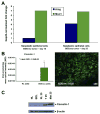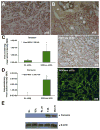Intrahepatic cholangiocarcinoma progression: prognostic factors and basic mechanisms
- PMID: 19896103
- PMCID: PMC3795391
- DOI: 10.1016/j.cgh.2009.08.023
Intrahepatic cholangiocarcinoma progression: prognostic factors and basic mechanisms
Abstract
In this review, we will examine various molecular biomarkers for their potential to serve as independent prognostic factors for predicting survival outcome in postoperative patients with progressive intrahepatic cholangiocarcinoma. Specific rodent models of intrahepatic cholangiocarcinoma that mimic relevant cellular, molecular, and clinical features of the human disease are also described, not only in terms of their usefulness in identifying molecular pathways and mechanisms linked to cholangiocarcinoma development and progression, but also for their potential value as preclinical platforms for suggesting and testing novel molecular strategies for cholangiocarcinoma therapy. Last, recent studies aimed at addressing the role of desmoplastic stroma in promoting intrahepatic cholangiocarcinoma progression are highlighted in an effort to underline the potential value of targeting tumor stromal components together with that of cholangiocarcinoma cells as a novel therapeutic option for this devastating cancer.
Conflict of interest statement
Figures



References
-
- Hammill CW, Wong LL. Intrahepatic cholangiocarcinoma: a malignancy of increasing importance. J Am Coll Surg. 2008;207:594–603. - PubMed
-
- Blechacz BRA, Gores GJ. Cholangiocarcinoma. Clin Liver Dis. 2008;12:131–150. - PubMed
-
- Briggs CD, Neal CP, Mann CD, et al. Prognostic molecular markers in cholangiocarcinoma: a systematic review. Eur J Cancer. 2009;45:33–47. - PubMed
-
- Hirohashi K, Uenishi T, Kubo S, et al. Macroscopic types of intrahepatic cholangiocarcinoma: clinicopathologic features and surgical outcomes. Hepatogastroenterology. 2002;49:326–329. - PubMed
Publication types
MeSH terms
Substances
Grants and funding
LinkOut - more resources
Full Text Sources
Other Literature Sources
Medical
Molecular Biology Databases

